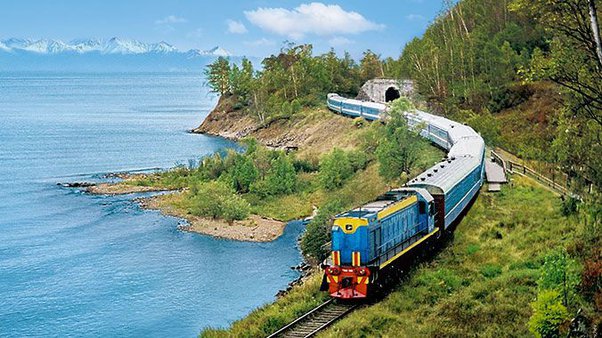Traversing the Trans-Siberian Railway: Unveiling Russia’s Vast Land.
The Trans-Siberian Railway is one of the most iconic and longest railway lines in the world, spanning across Russia’s vast land. This epic journey offers travelers a unique opportunity to traverse the diverse landscapes, cultures, and cities of Russia, providing an unforgettable experience. From the bustling metropolis of Moscow to the remote wilderness of Siberia, the Trans-Siberian Railway promises an adventure like no other. In this article, we will explore the highlights and challenges of embarking on this remarkable journey.
The History and Significance of the Trans-Siberian Railway
The Trans-Siberian Railway is a monumental feat of engineering that stretches across the vast expanse of Russia. Spanning over 9,000 kilometers, it is the longest railway line in the world. The construction of this railway began in 1891 and was completed in 1916, taking a total of 25 years to finish. The main purpose of the Trans-Siberian Railway was to connect the far-flung regions of Russia and promote economic development in the country.
The idea for the Trans-Siberian Railway originated in the late 19th century when Russia’s leaders recognized the need for a reliable transportation system to connect the remote areas of the country. At that time, Russia was experiencing rapid industrialization, and the government saw the railway as a means to transport goods and resources more efficiently. Additionally, the railway would also serve as a vital link between the European part of Russia and its eastern territories.
The construction of the Trans-Siberian Railway was an immense undertaking. It required the labor of thousands of workers, including engineers, laborers, and soldiers. The harsh climate and challenging terrain posed significant obstacles during the construction process. The railway had to traverse vast stretches of uninhabited land, dense forests, and treacherous mountain ranges. Bridges and tunnels had to be built to overcome natural barriers, and countless kilometers of track had to be laid.
Despite the difficulties, the construction of the Trans-Siberian Railway proceeded steadily. The railway was divided into several sections, each with its own set of challenges. The most challenging section was the one that crossed the Ural Mountains, which required the construction of numerous tunnels and bridges. The completion of this section was a significant milestone in the construction process.
The Trans-Siberian Railway played a crucial role in the development of Russia. It facilitated the transportation of goods and resources, connecting the resource-rich regions of Siberia with the industrial centers in the west. The railway also opened up new opportunities for trade and commerce, allowing for the growth of towns and cities along its route. It became a lifeline for the people living in remote areas, providing them with access to essential goods and services.
During the early years of its operation, the Trans-Siberian Railway was primarily used for freight transportation. However, as the railway network expanded and improved, passenger services were introduced. The railway became a popular mode of travel for both domestic and international tourists, offering them a unique opportunity to experience the vastness and diversity of Russia’s landscapes.
Today, the Trans-Siberian Railway remains an iconic symbol of Russia’s engineering prowess and its vastness as a country. It continues to serve as a vital transportation link, connecting the different regions of Russia and promoting economic growth. The railway has also become a popular tourist attraction, with travelers from around the world embarking on the epic journey across Russia’s vast land.
In conclusion, the Trans-Siberian Railway is a testament to human ingenuity and determination. Its construction was a monumental undertaking that required years of hard work and perseverance. The railway has played a significant role in the development of Russia, connecting its far-flung regions and promoting economic growth. Today, it stands as a symbol of Russia’s engineering prowess and offers travelers a unique opportunity to traverse the vastness of the country.
Exploring the Scenic Beauty Along the Trans-Siberian Railway
The Trans-Siberian Railway is not only the longest railway line in the world, but it is also a gateway to some of the most breathtaking landscapes on Earth. As the train traverses across Russia’s vast land, passengers are treated to a visual feast of scenic beauty that is unparalleled. From the dense forests of Siberia to the majestic mountains of the Ural region, this journey is a once-in-a-lifetime experience for any traveler.
One of the highlights of the Trans-Siberian Railway is Lake Baikal, the deepest and oldest freshwater lake in the world. As the train approaches this natural wonder, passengers are greeted with stunning views of crystal-clear waters and snow-capped mountains. The lake is home to a unique ecosystem, with over 1,700 species of plants and animals, many of which are found nowhere else on Earth. Travelers can take a break from the train and explore the surrounding area, hiking along the shoreline or taking a boat ride to one of the nearby islands.
Continuing eastward, the train passes through the vast Siberian taiga, a dense forest that stretches for thousands of kilometers. This pristine wilderness is home to a diverse range of wildlife, including bears, wolves, and reindeer. As the train chugs along, passengers can catch glimpses of these majestic creatures in their natural habitat. The taiga is also a paradise for birdwatchers, with over 300 species of birds calling this region home. Travelers can immerse themselves in the tranquility of the forest, taking in the fresh air and listening to the sounds of nature.
As the train crosses the Ural Mountains, passengers are treated to panoramic views of rugged peaks and deep valleys. This mountain range, which separates Europe from Asia, is a geological marvel. Travelers can marvel at the sheer size and beauty of these mountains, as well as explore the charming towns and villages nestled in their foothills. The Ural region is also known for its rich history and cultural heritage, with numerous museums and historical sites to visit.
The journey along the Trans-Siberian Railway is not just about the natural beauty, but also about the cultural diversity of the regions it passes through. As the train makes its way through different cities and towns, passengers can witness the unique traditions and customs of the Russian people. From the vibrant city of Moscow to the historic city of Irkutsk, each stop along the way offers a glimpse into the rich tapestry of Russian culture.
In conclusion, exploring the scenic beauty along the Trans-Siberian Railway is a truly unforgettable experience. From the breathtaking landscapes of Lake Baikal to the pristine wilderness of the Siberian taiga, this journey offers a unique opportunity to immerse oneself in the natural wonders of Russia. The Ural Mountains provide a dramatic backdrop, while the diverse cultures and traditions of the regions add depth and richness to the journey. Whether you are a nature lover, a history enthusiast, or simply seeking an adventure, the Trans-Siberian Railway is a must-see destination that will leave you in awe of Russia’s vast and diverse land.
Cultural Encounters and Experiences on the Trans-Siberian Railway
Traversing the Trans-Siberian Railway: A Journey Across Russia’s Vast Land
Embarking on a journey across Russia’s vast land, the Trans-Siberian Railway offers a unique opportunity to experience the rich cultural encounters that await travelers along its route. As one of the longest railway lines in the world, spanning over 9,000 kilometers, this iconic railway provides a fascinating glimpse into the diverse cultures and traditions that make up the fabric of Russia.
Starting in Moscow, the Trans-Siberian Railway takes passengers on an unforgettable adventure through the heart of Russia. The first stop on this cultural journey is Yekaterinburg, a city steeped in history and known for its connection to the Romanov dynasty. Here, visitors can explore the Church on the Blood, a memorial built on the site where the last Russian Tsar, Nicholas II, and his family were executed. This somber reminder of Russia’s past serves as a poignant introduction to the cultural encounters that lie ahead.
Continuing eastward, the Trans-Siberian Railway reaches the city of Irkutsk, often referred to as the “Paris of Siberia.” This charming city is renowned for its well-preserved wooden architecture, which provides a glimpse into the traditional way of life in Siberia. Visitors can stroll through the historic district, admiring the intricately carved facades of the wooden houses and immersing themselves in the local culture.
From Irkutsk, a short journey takes travelers to Lake Baikal, the deepest and oldest freshwater lake in the world. This natural wonder is not only a breathtaking sight but also a place of great cultural significance. The indigenous Buryat people, who have inhabited the region for centuries, consider the lake to be sacred. Visitors can learn about their traditions and customs, as well as enjoy the stunning scenery that surrounds them.
As the Trans-Siberian Railway continues its eastward journey, it reaches Ulan-Ude, the capital of the Buryat Republic. Here, travelers have the opportunity to delve deeper into Buryat culture by visiting the Ivolginsky Datsan, a Buddhist monastery that serves as a spiritual center for the region’s Buddhist community. The vibrant colors and intricate designs of the temple’s architecture are a testament to the rich cultural heritage of the Buryat people.
Further along the route, the Trans-Siberian Railway arrives in Vladivostok, the final destination of this epic journey. This bustling port city, located on the Pacific coast, offers a unique blend of Russian and Asian influences. Visitors can explore the city’s vibrant markets, sample local delicacies, and soak in the atmosphere of this cosmopolitan hub.
Throughout the journey on the Trans-Siberian Railway, travelers are not only treated to breathtaking landscapes but also to a myriad of cultural encounters. From the historical significance of Yekaterinburg to the traditional wooden architecture of Irkutsk, and from the sacred Lake Baikal to the spiritual center of Ulan-Ude, this railway journey offers a truly immersive experience into the diverse cultures that shape Russia.
As the train traverses the vast expanse of Russia, passengers have the opportunity to witness firsthand the rich tapestry of traditions, languages, and customs that make up this vast country. Whether it’s exploring historical landmarks, interacting with local communities, or simply admiring the stunning scenery, the Trans-Siberian Railway promises an unforgettable journey that will leave travelers with a deep appreciation for the cultural diversity of Russia.In conclusion, traversing the Trans-Siberian Railway offers a unique and captivating journey across Russia’s vast land. The railway provides an opportunity to witness the diverse landscapes, cultures, and history of this vast country. From the bustling city of Moscow to the remote wilderness of Siberia, this epic train journey offers a remarkable experience for travelers seeking adventure and a deeper understanding of Russia’s rich heritage. Whether it’s the breathtaking views of Lake Baikal, the architectural wonders of Irkutsk, or the vibrant markets of Vladivostok, the Trans-Siberian Railway promises an unforgettable expedition through the heart of Russia.




